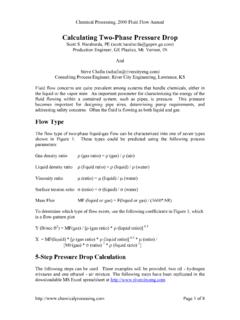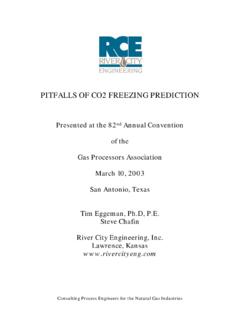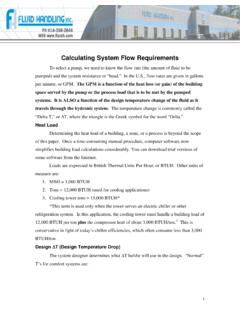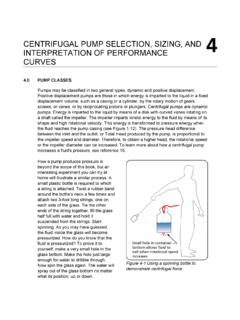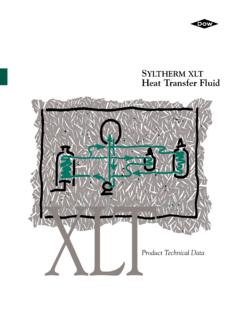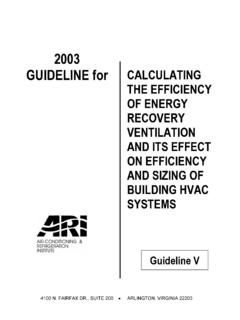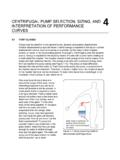Transcription of Calculating Two-Phase Pressure Drop - River City …
1 Chemical Processing, 2000 fluid Flow 1 of 8 Calculating Two-Phase Pressure DropScott S. Haraburda, PE Engineer, GE Plastics, Mt. Vernon, INAndSteve Chafin Process Engineer, River City Engineering, Lawrence, KSFluid flow concerns are quite prevalent among systems that handle chemicals, either inthe liquid or the vapor state. An important parameter for characterizing the energy of thefluid flowing within a contained system, such as pipes, is Pressure . This pressurebecomes important for designing pipe sizes, determining pump requirements, andaddressing safety concerns. Often the fluid is flowing as both liquid and TypeThe flow type of Two-Phase liquid-gas flow can be characterized into one of seven typesshown in Figure 1.
2 These types could be predicted using the following processparameters:Gas density ratio (gas ratio) = (gas) / (air)Liquid density ratio (liquid ratio) = (liquid) / (water)Viscosity ratio (ratio) = (liquid) / (water)Surface tension ratio (ratio) = (liquid) / (water)Mass FluxMF (liquid or gas) = F(liquid or gas) / (3600*AR)To determine which type of flow exists, use the following coefficients in Figure 1, whichis a flow-pattern (lb/sec ft2) = MF(gas) / [ (gas ratio) * (liquid ratio)] = MF(liquid) * [ (gas ratio) * (liquid ratio)] * (ratio) / [MF(gas) * (ratio) 3 * (liquid ratio) 2]5-Step Pressure drop CalculationThe following steps can be used.
3 Three examples will be provided, two oil - hydrogenmixtures and one ethanol - air mixture. The following steps have been replicated in thedownloadable MS Excel spreadsheet at Processing, 2000 fluid Flow 2 of 8 Step 1: Select the pipe choosing the nominal pipe size, ensure that you have the appropriate insidediameter, based upon the pipe schedule. For the provided examples, a 4 inch standardpipe will be used for the oil - hydrogen mixtures and a 1 inch standard pipe will be usedfor the ethanol - air mixture. Both have an absolute roughness ( ) of AreaAR = ( * d2) / 576 Step 2: Obtain the process important properties are flow rate (F), safety factor (SF), density ( ), viscosity ( ),and surface tension ( ).
4 The first example has a 5,000 lb/hr flow, a lb/ft3 density, a15 cP viscosity, and a 20 dynes / cm surface tension for the liquid (oil). The gas(hydrogen) is flowing at 800 lb/hr, with a lb/ft3 density and a cP second example is the same as the first, with the exception that the liquid flow is140,000 lb/hr. The third example has a lb/hr flow, a lb/ft3 density, a cPviscosity, and a dynes/cm surface tension for the liquid (ethanol). The gas (air) isflowing at lb/hr, with a lb/ft3 density and a cP viscosity. For allthree examples, there is no safety factor (SF=1).Step 3: Calculate the single phase line sizing Pressure following equations are used to calculate this Pressure drop for both the liquid andthe gas phase = F * SF / (3600 * * AR)Reynolds NumberRe = * F * SF / ( * d * )Friction Factorf = 64 / Refor Re < 2100f = 8 * [(8/Re) 12 + 1/(A + B) ]1/12whereA = [ * ln(1 / ((7/Re) + * / d))]16B = (37,530/Re)16 Pressure drop P = * f * v2 * / (gc * d) (this is in per 100 ft)The first example has a ft/sec velocity, a 523 Reynolds Number, a friction factor and a Pressure drop of psi / 100 ft of pipe for the liquid.
5 The gas is flowing ft/sec, with a Reynolds Number of 105,000, a friction factor of and a pressuredrop of psi / 100 ft. The second example has the same gas properties as the firstexample. However, the liquid is flowing at ft/sec, with a Reynolds Number of14,600, a friction factor of and a Pressure drop of psi / 100 ft. The thirdexample has a ft/sec velocity, a 893 Reynolds Number, a friction factor of anda Pressure drop of psi / 100 ft. The gas is flowing at ft /sec, with a ReynoldsNumber of 66,000, a friction factor of and a Pressure drop of psi / 100 Processing, 2000 fluid Flow 3 of 8 Step 4: Calculate the two phase line sizing properties.
6 The density, velocity, and viscosity are averaged for a characteristic property of thecombined phases in the fluid flow. And, the resulting Two-Phase Reynolds Number iscalculated. The following equations are used:Avg. density (average) = (F(gas) + F(liquid))/(F(gas)/ (gas) + F(liquid)/ (liquid))Avg. velocity v(average) = (F(gas) + F(liquid)) / ( (average) * AR)Avg. viscosity (average) = (F(gas) + F(liquid))/(F(gas)/ (gas) + F(liquid)/ (liquid))Figure 2 depicts values for this step and the next step for the examples 5: There are three different types of Two-Phase Pressure drop are determined by the viscosity ratio and the mass flux.
7 A. For viscosity ratios greater than 1000 and a mass flux greater than , use theChisholm-Baroczy (C-B) method [see example 1]. The C-B method is unique in that thepressure drops for each of the phases are calculated assuming that the total mixture flowsas either liquid or gas. Therefore:F(total) = F(liquid) +F(gas)MF = F(total) / (3600*AR)It should be noted that the Reynolds number and friction factor for each phase is alsocalculated assuming it is a function of total (liquid or gas) = [F(total), SF, d, (liquid or gas)]f (liquid or gas) = [Re(liquid or gas), / d] P(liquid or gas) = * f * MF2 / (gc * (liquid or gas) * d) (this is in per 100 ft)A Pressure ratio is calculated:PR = [ P(gas) / P (liquid)] this Pressure ratio, a C-B constant is calculated.
8 CB = / MF PR < = / (PR * MF )for < PR < 28CB = / (PR2 * MF )for PR > 28 Chemical Processing, 2000 fluid Flow 4 of 8 Now, the C-B Pressure correction factor and the associated Two-Phase Pressure drop iscalculated: (C-B) = 1 + (PR2 - 1) * (CB * (xg((2-n)/2) ) * ((1-xg) ((2-n)/2) ) + xg (2-n) )Where xg = F(gas) / (F(gas) + F(liquid)) and n= P (C-B) = * (C-B) * f(liquid) * MF2 / (gc * (liquid) * d) (this is in per 100 ft)b. For viscosity ratios greater than 1000 and a mass flux less than , use the Lockhart- Martinelli (L-M) method [see example 2]. The Reynolds Number for both the liquidand the gas are used. Unlike the C-B method, the separate Pressure drops for both theliquid and the gas are used explicitly, along with the Pressure ratio.
9 Using these, a uniqueL-M Pressure correction factor for each phase is calculated. This requires the use of adifferent Pressure factor than the C-B method:PR = ln [( P (liquid) / P (gas)) ]b1. For Re(liquid) > 2100 and Re(gas) > 2100: (liquid) = *PR+ * * *PR4 (gas) = + *PR+ * * *PR4b2. For Re(liquid) > 2100 and Re(gas) < 2100: (liquid) = *PR+ * * *PR4 (gas) = + *PR+ * * *PR4b3. For Re(liquid) < 2100 and Re(gas) > 2100: (liquid) = *PR+ * * *PR4 (gas) = + *PR+ * * *PR4b4. For Re(liquid) < 2100 and Re(gas) < 2100: (liquid) = *PR+ * * *PR4 (gas) = + *PR+ * * *PR4 Now, a separate Pressure drop is calculated for each phase: P(liquid1) = [exp[ (liquid)]]2 * P (liquid) P(gas1) = [exp[ (gas)]]2 * P (gas)Then, the estimated Two-Phase Pressure drop is the maximum of these: P(L-M) = max { P(liquid1), P (gas1)}Chemical Processing, 2000 fluid Flow 5 of 8c.
10 Finally, for viscosity ratios less than 1000, use the Friedel method [see example 3]. Inaddition to the Reynolds number, the Froude number and Weber numbers are used. In thefollowing equations, be sure to use the mass flux of the total mass (liquid+gas) flowing inthe NumberFr = 12 * MF2 / (gc * (average)2 * d)Weber NumberWe = * d * MF2 / ( (average) * )A gas mass ratio and two Friedel coefficients are also used:Gas mass ratio xg = F(gas) / [F(liquid) + F(gas)]Calculate 1 for both phases using the Reynolds number calculated for each phase:Friedel coefficient 1 1 = 64 / Refor Re < 1055 1 = [ * ln(Re/( *ln(Re) - ))] -2 for Re > 1055 Friedel coefficient 2 2 = (1- xg)2 + (xg 2) * [ (liquid) * 1(gas) / { (gas) * 1(liquid)}]Two Pressure correction factors are used, one for horizontal flow (which includes verticalup) and another for vertical down flow.
